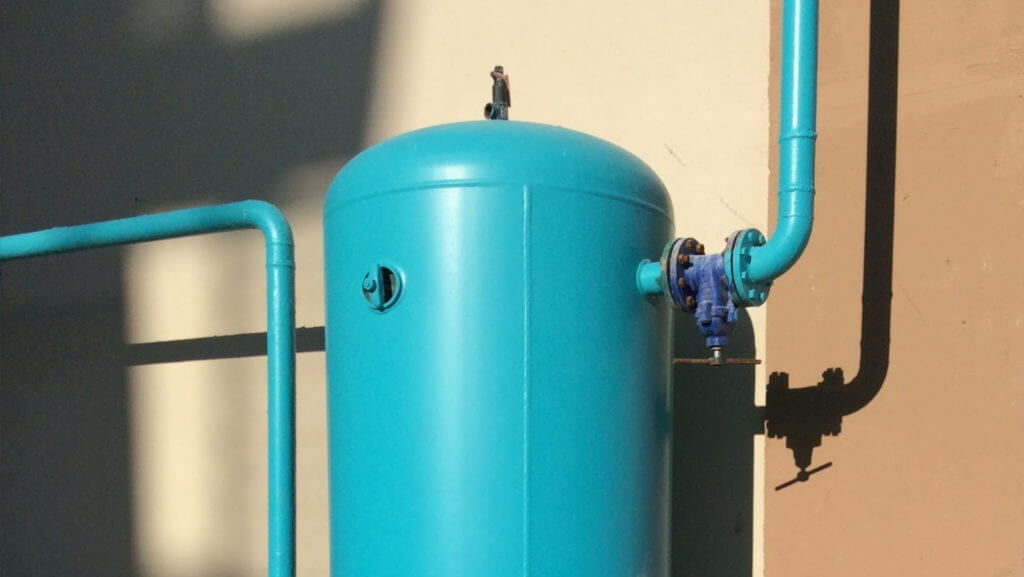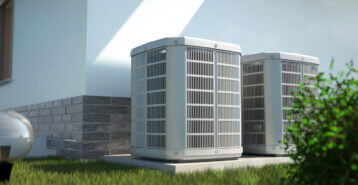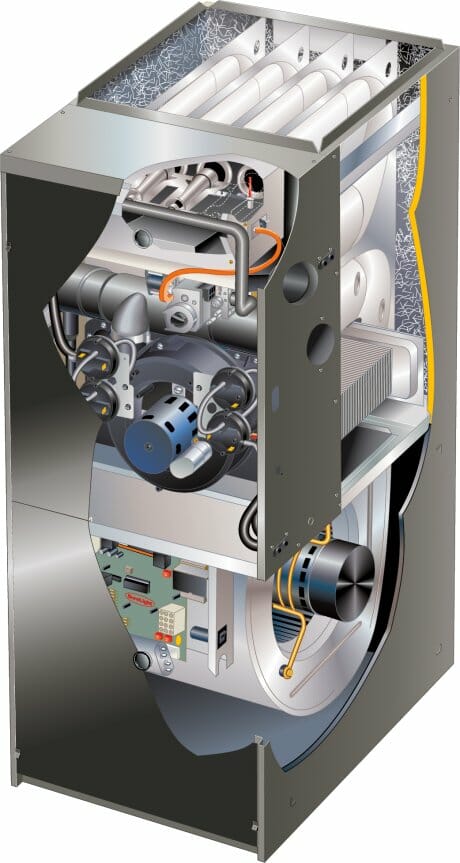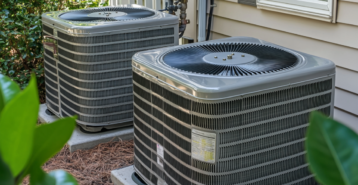Are you doing an HVAC project?
Modernize can pair you with three to four pros in your area, so you can compare options and save time and money.
What is a Furnace?
A furnace is a heating unit that generates and distributes warm air throughout your home. It is one of the oldest heating systems still in use today, found in both residential and commercial buildings. Early furnaces were fueled by coal or wood, while modern models rely on natural gas, propane, oil, or electricity.
Although the basic operation is similar across all furnaces, the way they function can vary. Furnaces are commonly categorized by their design—single-stage, two-stage, or variable speed—as well as by their fuel source: gas, oil, or electric. Each type comes with its own characteristics, efficiency ratings, and costs, which play an important role in determining the right fit for your home.
How Does a Furnace Work?
To understand how a furnace works, we will take an example of a gas-powered furnace, also known as a forced-warm air distribution system. If you’re looking for a shorter explanation, scroll down to the next section for a quick, step-by-step recap.
A furnace consists of six main components:
- Thermostat
- Gas Valve
- Burners
- Heat Exchanger
- Blower
- Air Ducts
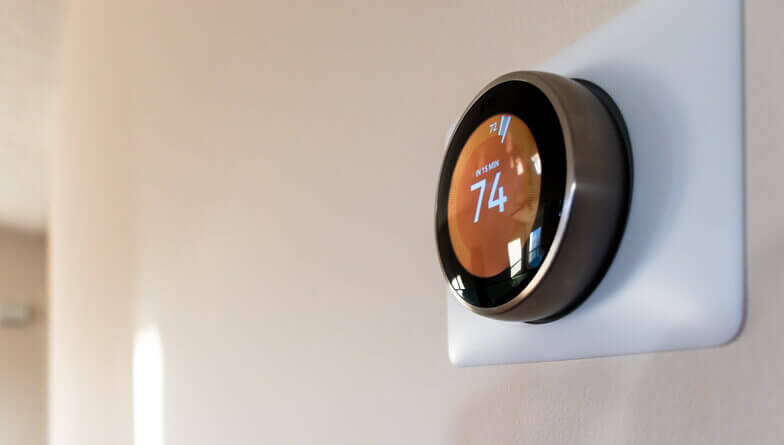
A thermostat activates a furnace when the indoor temperature drops below the level you’ve set. Once triggered, the gas valve opens and supplies fuel to the burners, which ignite inside the combustion chamber. Older furnaces relied on a pilot light, but most modern models use an electronic ignitor for safer, more efficient starts.
The heat produced warms the heat exchanger, which is designed to safely separate combustion gases from the air circulating through your home. As cooler indoor air enters through return ducts, it passes over the exchanger and absorbs the heat.
Before moving through your ductwork, the warmed air travels through a filter that captures dust and debris. It then enters the furnace plenum, a central chamber that directs the heated air into ducts. From there, a blower motor pushes the clean, warm air throughout your living spaces.
At the same time, harmful combustion by-products are vented outdoors through flue and exhaust pipes. This cycle continues — pulling in cooler air, reheating it, and distributing warm air — until the thermostat signals that your desired temperature has been reached. At that point, the gas valve shuts off until the next heating cycle begins.
Furnaces often work alongside central air conditioners or heat pumps, sharing the same blower and duct system. This setup provides year-round comfort by delivering both warm and cool air as needed.
How Does a Furnace Work Step by Step?
A furnace heats your home by drawing in air, warming it, and sending it back through your ducts. The process typically follows these steps:
- The thermostat senses a drop in temperature and signals the furnace to start.
- The draft fan pulls in air for combustion.
- The burners ignite, fueled by natural gas, propane, or electricity.
- Heat is transferred to the heat exchanger.
- The blower fan pushes warm air through ducts into your home.
- Exhaust gases safely exit through a vent or flue.
This cycle repeats until your home reaches the temperature set on your thermostat.
Types of Furnaces: How They Work
Furnaces operate in different ways depending on their design. Understanding the differences between single-stage, two-stage, and variable speed models can help you choose the right system for your home.
Single-Stage Furnace
A single-stage furnace has a gas valve with only two settings: on and off. Because it runs at full capacity whenever it operates, it delivers consistent heat but with less efficiency. These systems are often called single-speed furnaces since the blower runs at one speed during operation.
Two-Stage Furnace
A two-stage furnace offers greater efficiency and comfort than a single-stage model. Its gas valve has three positions: closed, partially open, and fully open. The furnace usually runs in the first stage at about 65% capacity, which is ideal for moderate heating needs. When temperatures drop, it automatically switches to the second stage to deliver full heating power. Many homeowners prefer two-stage furnaces because they balance comfort and energy savings.
Find the Right Contractor for Your HVAC Project
Whether you’re ready to begin your project now or need some expert advice, our network of contractors are here to help. With a few simple questions, we’ll find the best local professionals for you
Variable Speed Furnace
A variable speed furnace refers to the blower motor, not the burner itself. The blower can adjust its speed in small increments to control how much heated air is circulated through your home. By running at lower speeds for longer periods, the furnace maintains steady temperatures, improves air quality, and lowers energy costs.
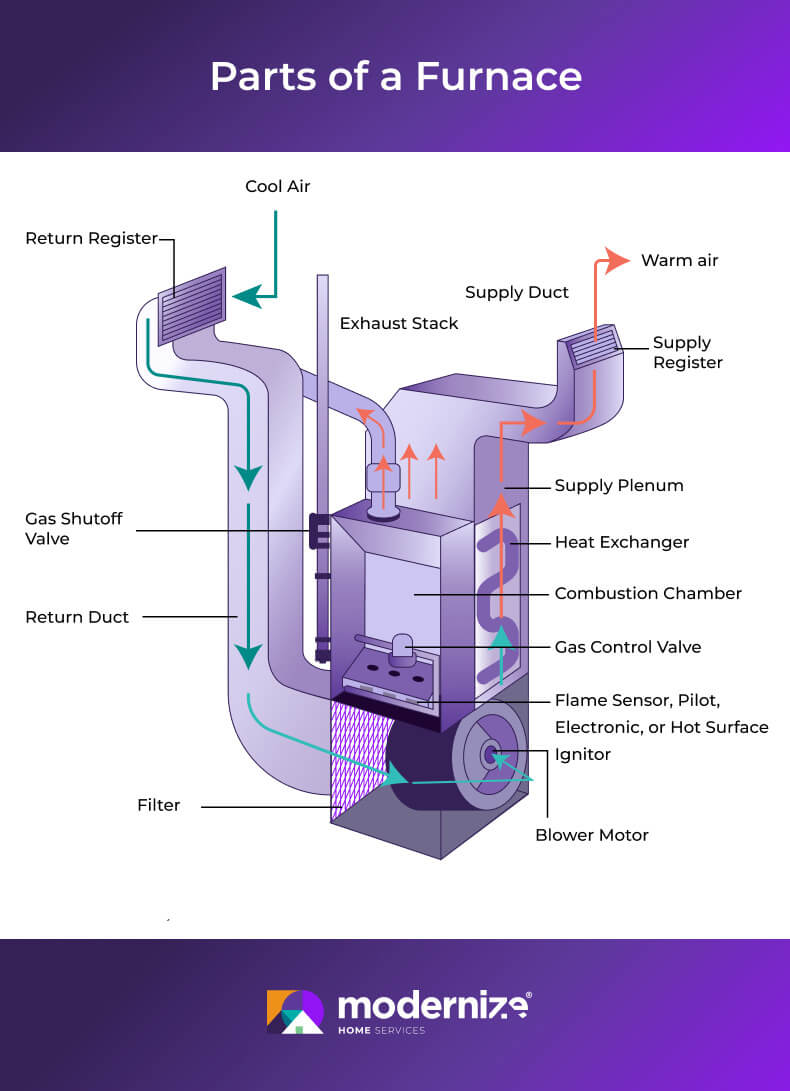
Types of Furnaces: Fuel Used
Furnace FAQs
What is the most common part to fail on a furnace?
The most common part to fail is the ignitor. Over time, the ignitor can wear out or crack, preventing the burners from lighting. Other frequent issues include dirty filters, worn blower motors, and faulty limit switches. Regular maintenance helps catch these problems early and extend the life of your system.
What tells the furnace to kick on?
Your thermostat controls when the furnace turns on. When the indoor temperature falls below the setting, the thermostat signals the control board inside your furnace. This starts the ignition process, allowing the system to produce and circulate heat until your home reaches the desired temperature.
How does a furnace work with AC?
In most homes, the furnace and air conditioner share the same blower motor and ductwork. The furnace handles heating during cold months, while the AC cools the air in summer. The thermostat switches between the two systems, ensuring your home stays comfortable year-round.
Which Furnace Should You Get?
Choosing the right furnace depends on several factors, including your local climate, energy costs, the size of your home, insulation levels, and even the brand of system you prefer.
For many homeowners, a two-stage furnace is a smart investment. While it costs more upfront than a single-stage model, it offers better efficiency and comfort, especially in colder regions. However, the best choice ultimately comes down to your budget and specific heating needs.
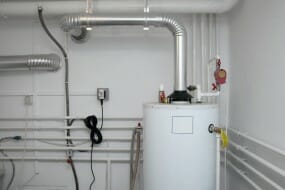
An HVAC professional can guide you through this decision by inspecting your home, evaluating your ductwork, and identifying areas that may need upgrades. They may also point out deficiencies such as poor insulation or air leaks around windows and doors—issues that affect both heating and cooling efficiency.
Keep in mind that replacing both your furnace and central air conditioner at the same time will raise your total HVAC replacement costs. However, doing both together can also ensure your system works seamlessly and may save you money on installation in the long run.
Choosing an HVAC Contractor
A furnace is a major investment, and proper installation is essential for performance, efficiency, and safety. When selecting an HVAC contractor, look for:
- Licensing and insurance in your state
- Strong local experience and customer reviews
- Knowledge of multiple furnace types and brands
- Clear, written estimates for installation or replacement
- Availability for emergency service and ongoing maintenance
Working with a trusted professional ensures your furnace is correctly sized and installed for your home, helping you get the most out of your heating system for years to come.
Next Steps for Your Furnace Project
Whether you’re maintaining an older furnace or considering a replacement, the key is finding a reliable contractor who can guide you through the process.
Modernize connects homeowners with trusted local HVAC professionals who can provide estimates, recommend the best furnace for your needs, and ensure your installation is done correctly. With expert help, you’ll enjoy a safer, more efficient heating system that keeps your home comfortable for years to come.
Find the Right Contractor for Your HVAC Project
Whether you’re ready to begin your project now or need some expert advice, our network of contractors are here to help. With a few simple questions, we’ll find the best local professionals for you
Reviews from Real Homeowners
Welcome to Homeowner Resources! We are the Modernize blog. Modernize pairs more than 3 million homeowners a year with pre-vetted contractors in their area. This blog started because we believe homeowners should know everything about their homes, from how their HVAC works to which front door colors they might love. On Homeowner Resources, you can find information on every part of your home, right down to how you can negotiate with contractors to get the best price. Here's more about the blog.
Need a contractor? Learn more about how Modernize finds the right pro for you.

